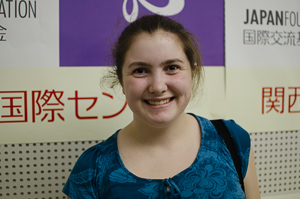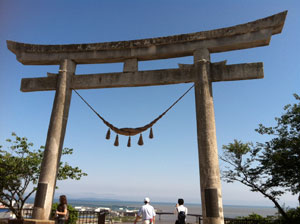

 Emily Grabowski
Emily Grabowski
Inglemoor High School
Kenmore, WA
I remember sitting in the back seat of the bus, on our first day in Tohoku. Light rain continuously interrupted our pictures of the beautiful countryside. Our bus had to keep turning around and retracing its steps, and I was just looking out the window at the fields passing by. Then Thomas picked up the microphone and told us that the fields we were looking at were actually neighborhoods that had been literally flattened by the tsunami. Silence blanketed the bus and we began to see the faint outlines of foundations. In that moment I realized the seriousness of this trip.
The next night was my favorite night of the trip. We were in a restaurant with Japanese students that we had met earlier in a summit about how to best improve the area. I remember feeling shy and awkward, but two Japanese students invited me to eat noodles with them. We talked over our dinner and we were able to connect over hobbies and pop culture. By the end of the night, we were all singing and playing games, and I remember being greatly impressed by their attitude and kindness towards us.
Through these two experiences, I was able to grasp the true meaning of the trip. We were not there to gawk and take pictures, but instead we were there to connect with Japanese people in person and take those connections home with us. Everything we did, from studying to visiting high schools to sightseeing, was for this purpose. In this small way, I can help improve US-Japan relations.
In addition to the Tohoku tour, we also participated in homestays, toured the areas affected by the tsunami, experienced the Japanese lifestyle, and studied Japanese. I was able to improve my Japanese through conversation and immersion. We were able to stay in various places, from the Japan Foundation Japanese Language Institute in Osaka to the traditional Hotel Boyo in Tohoku. Through this immersive Japanese experience, in a short two weeks, I was able to experience a disproportionate of Japanese culture and language.
This trip showed me just how powerful language is since I was able to connect with students despite the language barrier and cultural differences. Before the trip, I was not certain how I was going to make Japanese a part of my life. But now my plans are to study Japanese through college and do a study abroad in Japan during my junior year. I am most likely not going to major in Japanese language, since my interests lie more in the field of psychology, but I want to use my Japanese in my chosen field.
After college, I want to apply to be a JET-CIR, or Coordinator for International Relations, and work in a town hall in Japan to help translate and teach English. I also want to pass the JLPT N1, a very high level Japanese proficiency test. My current dream for after college and JET is to apply for a grant to conduct psychological studies in Japan, so I can use my language skills as well as help foster understanding across cultures through my interest in psychology.
I began to foster this understanding in a small way when, the day I returned to the States, I went immediately to a family gathering. My aunts and uncles were all really curious about my experiences in Japan, so I had a chance to share a little about my trip. The part of the Tohoku tour that they were most impressed by was the ship that washed up in Rikuzentakata. They were shocked by not only the size of the ship but also by the distance it traveled from the ocean before coming to rest on top of a neighborhood. I also taught them a lot about Japanese culture that I learned during the course of my trip, and I feel like I have affected their impression of Japan by sharing with them my personal experience.
In order to share my experiences with more people, I am going to give a presentation to my Japanese class at school. In addition to this, I will also give a presentation to a few clubs in school. This is vital because people are very poorly informed about the earthquake and tsunami, and I feel as if I could make a difference for them by sharing my experiences.
Finally, I would like to thank Taylor Anderson and Monty Dickson for having such a beautiful dream to improve US-Japan relations and am grateful that I could take part in their dream. This trip made a big difference in my life, and if Monty and Taylor had not had such a dream, I probably would not have been able to go to Japan until I was in college. I am incredibly grateful to have this chance on the trip and hope that someday I too will be able to make a difference in US-Japan relations.

“Culture Still Stands”
This picture reminded me that the Japanese still treasured their culture even after an event like the tsunami. From the top of this mountain, we also had a good view of the destruction left behind by the tsunami, but even through it all, this mountain was an important thing to the people in Ishinomaki.